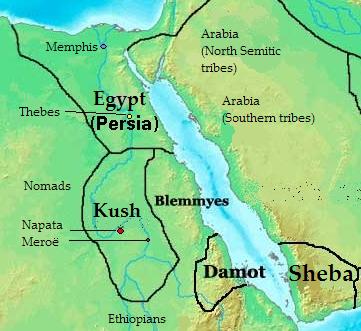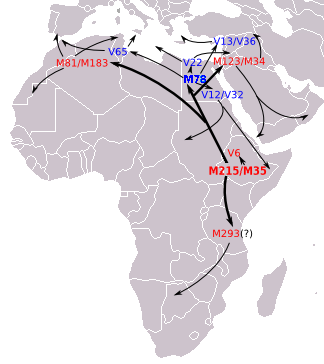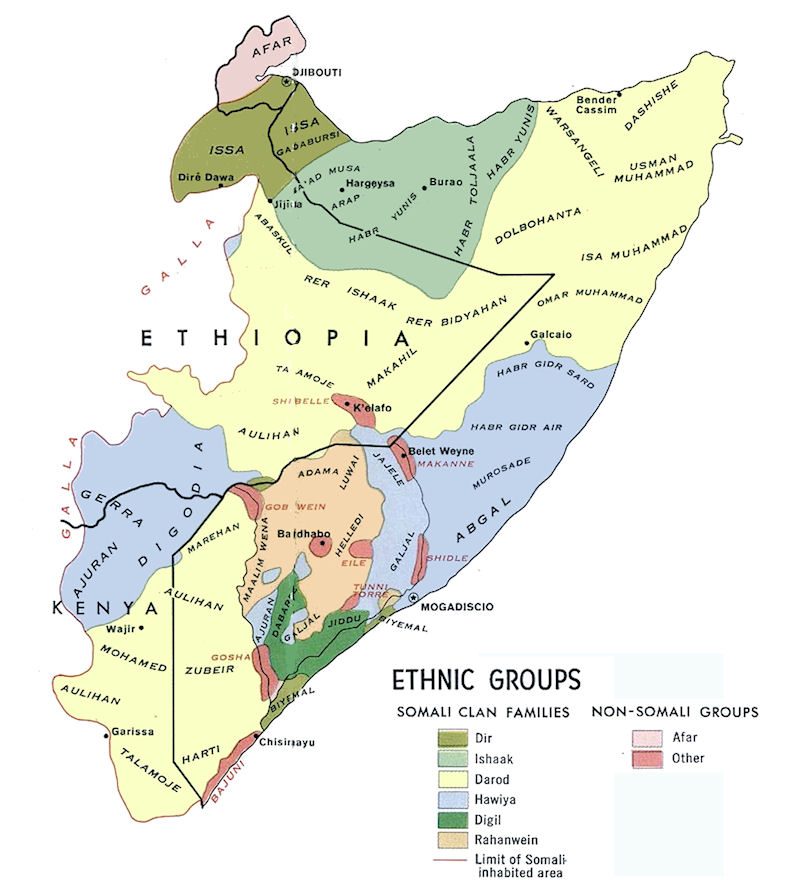Misrepresenting?
Since you have not taken up my challenge I have done some of the work:
https://www.phil.muni.cz/jazyk/files/AAmigrationsCORR.pdf
AFROASIATIC MIGRATIONS: LINGUISTIC EVIDENCE
"Having identified a Cushitic-like substratum in Modern South Arabian, Militarev (1984, 18-19; cf. also Belova 2003) proposes that Cushites
originally lived throughout the Arabian Peninsula; thus they would be the original southern neighbors of the Semites, who then assimilated those Cushites who did not move into Ethiopia. This hypothesis is supported byAnati (1968, 180-84), who analyzed the rock art of Central Arabia. He connected the pictures of the ‘oval-headed’ people depicted with shields with the Arabian ‘Cushites’ from the OldTestament [Genesis: 10.6-12; Isaiah 45.14] described also with specific shields [Jeremiah 46.9; Ezekiel 38.5].
The spread of Cushites in Africa is connected with the Rift Valley. In the coastal area of Eritrea and Djibuti, where the Rift enters into the African mainland, three archaic representatives
of the North, Central (= Agaw) and Eastern branches of Cushitic appear: Beja, Bilin and Afar-Saho respectively. In this place the disintegration of Cushitic probably began. Ancestors of the Agaw spread in the north of Eritrea and Ethiopia, the Beja also in Sudan between the Nile and the Red Sea. Other East and South Cushitic languages moved southward along the Rift Valley through Ethiopia, Kenya, as far as Central Tanzania. Partial migrations from the Rift inhabited areas more distant, e.g.the Horn by Somaloid populations (Heine 1978, 65-70) or the lower basin of the Tana in Kenya by the Dahalo and recently by the South Oromo. Concerning Ma’a, see Mous 2003."
If there was a Cushitic substrate in Arabia ( and this only says Cushitic-like), it would have come from the Rift valley and would have been either North, Central or Northeastern Cushitic. AfSamaale is Southeastern Cushitic, closely related to Rendille and Oromo, and there is nothing at all to suggest it crossed the Red Sea or was even near the north coast at an early period. M215 and M35, subclades of E1b1b, came up the Nile and then down the Dawa, or to the coastal plain at the Tana and then north. E1b1b comes from the south and west of Somalia. It's T and J that come from the north, as shown by the Dir and Warsangali as well as the DNA evidence. Only E1b1b is Cushitic. T is Persian and J is Semitic. Don't try to conflate any of this with later periods when assimilation had already occurred and the myths of additional Semitic ancestors had begun to pop up. Both DNA and linguistics say it wasn't so.
You have been reading a different Sada Mire than I have been reading.
https://link.springer.com/article/10.1007/s10437-015-9184-9#Sec8
Red Sea Sabaean/Himyarite and Pre-Askumite Empires (ca. Ninth Century BCE–Third Century CE)
"There is an extensive and ancient relationship between the people and cultures of both sides of the Red Sea coast (Phillipson
1998). Rock art sites such as Dhagah Nabi Gallay and Dhagah Kureh include Sabaean and Himyarite writings associated with South Arabia (see Map
3). In certain contexts, they appear to have been added to the rock art later, suggesting by superimposition. In 2007, more rock art sites with Sabaean and Himyarite writings in and around Hargeysa region were found, but sadly some were bulldozed by developers, as the Ministry of Tourism could not buy the land or stop the destruction. I have also recorded a burial site with such writings in Shalcaw (39), on the Red Sea coast (see Fig.
4). Furthermore, the Qar-Gebi megalithic burials include what might be ancient writings, perhaps Himyarite and Sabaean, but it needs to be confirmed. The Pre-Aksumite cultures of current-day Ethiopia are linked with South Arabian kingdoms.
The Pre-Aksumite Empire itself might have been part of, or at least culturally linked with, contemporary kingdoms in what is now the Somali-populated region. Not only are there links through the findings of Himyarite and Sabaean writings, but also early Christianity seems to have spread throughout the Horn, including the Somali region, as explored below. However, the burial site of Shal’aw is associated with other ancient burials in the immediate wadis in this sandy coastal landscape. The “wadi burials” are part of an ancient landscape that has been washed away by the floods and now exposed vertically, showing clear stratigraphic levels. If these burials can be rescued in time, there is a potential that we learn more about first-millennium BCE cultures of this little known Red Sea region, and associations with the Himyarite and Sabaean cultures, as well as perhaps ancient Egypt and the trade in frankincense and myrrh, still a big part of the economy in this area.
How is it you have such a hard time identifying Pre-Auxumites, Himyarites and Sabaeans as non-Samaales? Are they foreigners in relation to the present inhabitants of the North coast? Yes. They and the Harla were largely Semitic. Did they build that stuff? Sada Mire says so. Did Cushites or Samaales build the early stone cities or conduct the early trade? No. The northern clans don't form until the 12th-13th centuries and the first mention of Somali is 15th century. The previous population was largely Semitic and Haplotype"T". The Cushitic E1b1b arrives late and may not cover even all of the Isaaq, as the Habar Garhajis also have a lot of "T".





